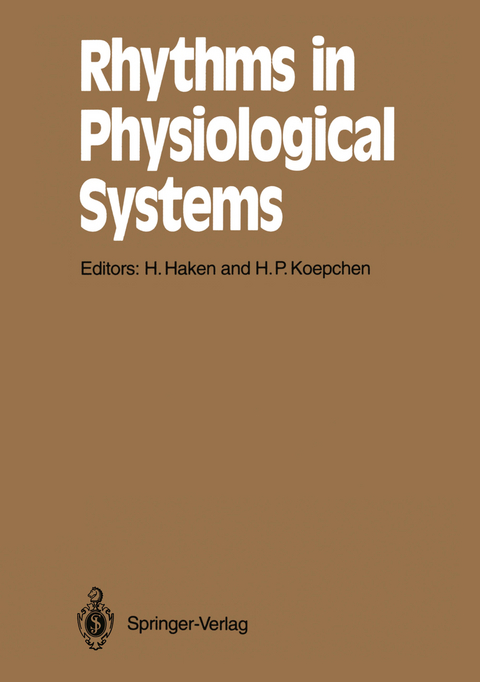
Rhythms in Physiological Systems
Springer Berlin (Verlag)
978-3-642-76879-8 (ISBN)
Hermann Haken is Professor of the Institute for Theoretical Physics at the University of Stuttgart. He is known as the founder of synergetics. His research has been in nonlinear optics (in particular laser physics), solid state physics, statistical physics, and group theory. After the implementation of the first laser in 1960, Professor Haken developed his institute to an international center for laser theory. The interpretation of the laser principles as self organization of non equilibrium systems paved the way to the development of synergetics, of which Haken is recognized as the founder. Hermann Haken has been visiting professor or guest scientist in England, France, Japan, USA, Russia, and China. He is the author of some 23 textbooks and monographs that cover an impressive number of topics from laser physics to synergetics, and editor of a book series in synergetics. For his pathbreaking work and his influence on academic research, he has been awarded many-times. Among others, he is member of the Order "Pour le merite" and received the Max Planck Medal in 1990.
I Physiological Rhythmicity and Synergetics.- Physiology of Rhythms and Control Systems: An Integrative Approach.- Synergetics - Can It Help Physiology?.- II Cardiovascular Rhythms.- Autorhythmicity in Blood Vessels: Its Biophysical and Biochemical Bases.- Role of the Rostroventrolateral Medulla in the Generation of Rhythmicities of the Sympathetic Activity.- Noninvasive Methods for Studying Rhythmic Nervous Control of Human Circulation.- The High Pressure System of the Mammalian Circulation as a Dynamic Self-Organizing System.- Spectral Analysis of Circulatory Rhythms and Baroreflex Sensitivity in Man.- Spectral Analysis of Cardiovascular Variables as a Tool to Quantify Neural Cardiovascular Control in the Laboratory and Real Life Conditions.- Cardiorespiratory Variability: Fractals, White Noise, Nonlinear Oscillators, and Linear Modeling. What's to Be Learned?.- Spectral Analysis as an Assessment of the Neural Control of the Heart: A Methodological Comparison.- Power Laws, Transients, Attractors, and Entropy: Possible Implications for Cardiovascular Dynamics.- III Respiratory Rhythms.- The Respiratory System - Features of Modulation and Coordination.- Phase Resetting of Respiratory Rhythm - Experiments in Animals and Models.- Rhythmogenesis of Deterministic Breathing Patterns.- IV Motor Coordination.- Synergetic Dynamics of Biological Coordination with Special Reference to Phase Attraction and Intermittency.- Synchronization of Rhythm in Motor Actions.- V Basis of Circadian Rhythmicities.- Interactions Between Human Circadian and (About 90 min) Sleep Rhythms: Problems in the Simulation and the Analysis.- VI Rhythms in Electrical Activity of the Brain.- The Information Content of the Human EEG.- Synergetics of Evoked Alpha and Theta Rhythms in the Brain:Topographic and Modality-Dependent Aspects.- EEG Rhythms - Event-Related Desynchronization and Synchronization.- VII Rhythms in Perception.- Psychological Modification and Synergetic Modelling of Perceptual Oscillations.- VIII Aspects of Systems Theory.- Spatio-Temporal EEG Patterns.- Information Processing by Systems with Chemical Communication.- Criteria for the Relative Degree of Order in Self-Organization Processes.- Index of Contributors.
| Erscheint lt. Verlag | 6.12.2011 |
|---|---|
| Reihe/Serie | Springer Series in Synergetics |
| Zusatzinfo | IX, 363 p. |
| Verlagsort | Berlin |
| Sprache | englisch |
| Maße | 170 x 242 mm |
| Gewicht | 642 g |
| Themenwelt | Naturwissenschaften ► Physik / Astronomie ► Angewandte Physik |
| Schlagworte | cardiovascular rhythms • circadian rhythms • EEG • perception • respiratory rhythms • Synergetics |
| ISBN-10 | 3-642-76879-2 / 3642768792 |
| ISBN-13 | 978-3-642-76879-8 / 9783642768798 |
| Zustand | Neuware |
| Informationen gemäß Produktsicherheitsverordnung (GPSR) | |
| Haben Sie eine Frage zum Produkt? |
aus dem Bereich


